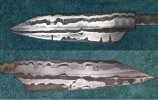- Joined
- Nov 15, 2005
- Messages
- 1,218
I’m looking to mess around with some canister Damascus and I was wondering if the 2% nickel addition into the 1084 powder, offered by Jantz, hurts blade performance in comparison to straight 1084 powder.
They say in the description that it basically performs like 15N20; yall think this is accurate? I hope that’s the case… I’ve read some legacy threads on here about how 15N20 is one of the most underrated “cheap” steels when it comes to performance. The extra nickel for the contrast would be nice astetically!
Any opinions welcome!
Cheers yall,
They say in the description that it basically performs like 15N20; yall think this is accurate? I hope that’s the case… I’ve read some legacy threads on here about how 15N20 is one of the most underrated “cheap” steels when it comes to performance. The extra nickel for the contrast would be nice astetically!
Any opinions welcome!
Cheers yall,
Last edited by a moderator:

